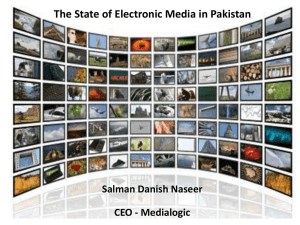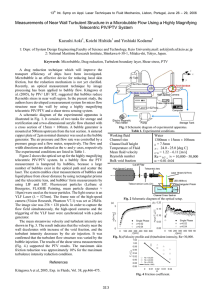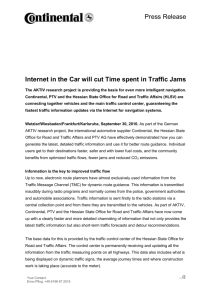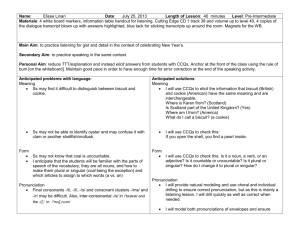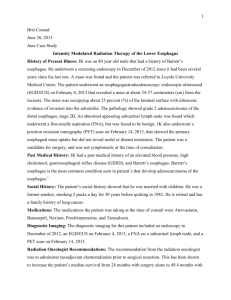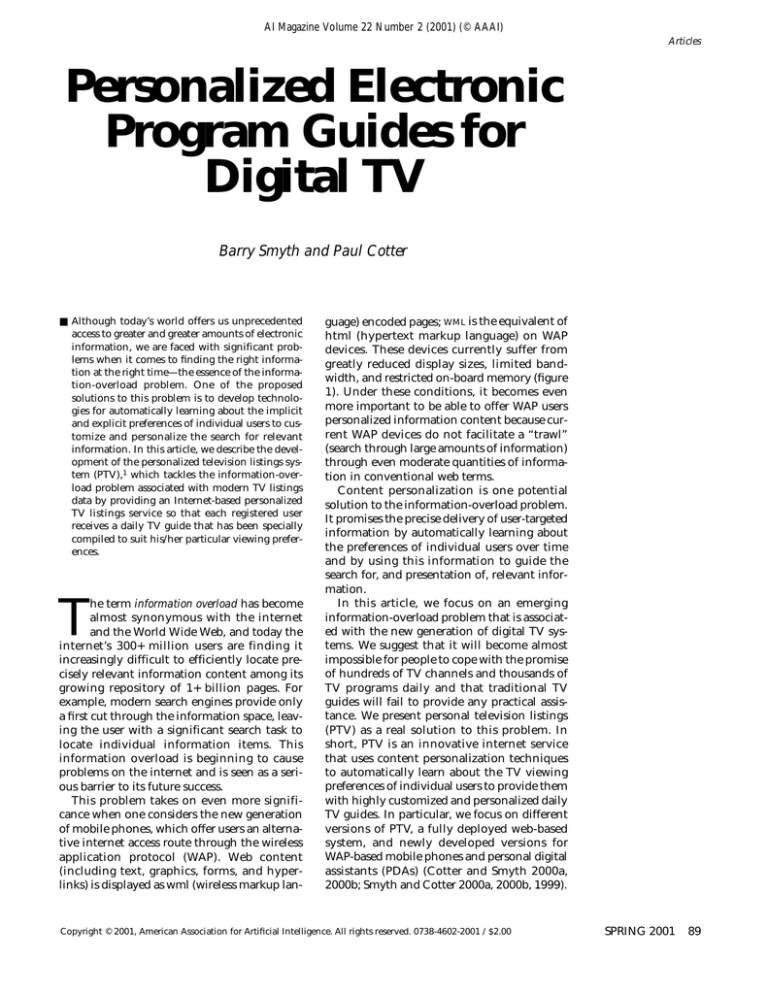
AI Magazine Volume 22 Number 2 (2001) (© AAAI)
Articles
Personalized Electronic
Program Guides for
Digital TV
Barry Smyth and Paul Cotter
■ Although today’s world offers us unprecedented
access to greater and greater amounts of electronic
information, we are faced with significant problems when it comes to finding the right information at the right time—the essence of the information-overload problem. One of the proposed
solutions to this problem is to develop technologies for automatically learning about the implicit
and explicit preferences of individual users to customize and personalize the search for relevant
information. In this article, we describe the development of the personalized television listings system (PTV),1 which tackles the information-overload problem associated with modern TV listings
data by providing an Internet-based personalized
TV listings service so that each registered user
receives a daily TV guide that has been specially
compiled to suit his/her particular viewing preferences.
T
he term information overload has become
almost synonymous with the internet
and the World Wide Web, and today the
internet’s 300+ million users are finding it
increasingly difficult to efficiently locate precisely relevant information content among its
growing repository of 1+ billion pages. For
example, modern search engines provide only
a first cut through the information space, leaving the user with a significant search task to
locate individual information items. This
information overload is beginning to cause
problems on the internet and is seen as a serious barrier to its future success.
This problem takes on even more significance when one considers the new generation
of mobile phones, which offer users an alternative internet access route through the wireless
application protocol (WAP). Web content
(including text, graphics, forms, and hyperlinks) is displayed as wml (wireless markup lan-
guage) encoded pages; WML is the equivalent of
html (hypertext markup language) on WAP
devices. These devices currently suffer from
greatly reduced display sizes, limited bandwidth, and restricted on-board memory (figure
1). Under these conditions, it becomes even
more important to be able to offer WAP users
personalized information content because current WAP devices do not facilitate a “trawl”
(search through large amounts of information)
through even moderate quantities of information in conventional web terms.
Content personalization is one potential
solution to the information-overload problem.
It promises the precise delivery of user-targeted
information by automatically learning about
the preferences of individual users over time
and by using this information to guide the
search for, and presentation of, relevant information.
In this article, we focus on an emerging
information-overload problem that is associated with the new generation of digital TV systems. We suggest that it will become almost
impossible for people to cope with the promise
of hundreds of TV channels and thousands of
TV programs daily and that traditional TV
guides will fail to provide any practical assistance. We present personal television listings
(PTV) as a real solution to this problem. In
short, PTV is an innovative internet service
that uses content personalization techniques
to automatically learn about the TV viewing
preferences of individual users to provide them
with highly customized and personalized daily
TV guides. In particular, we focus on different
versions of PTV, a fully deployed web-based
system, and newly developed versions for
WAP-based mobile phones and personal digital
assistants (PDAs) (Cotter and Smyth 2000a,
2000b; Smyth and Cotter 2000a, 2000b, 1999).
Copyright © 2001, American Association for Artificial Intelligence. All rights reserved. 0738-4602-2001 / $2.00
SPRING 2001
89
Articles
Problem Description
PC-based Web Access
Unrestricted page size
33kbps – 10Mbps
WAP-based Web Access
Device dependent page size
1397 bytes, approximately 9.6kbps
Figure 1. Compared to the Traditional Mode of Web Access,
the PC, Wireless Application Protocol (WAP)–Based Access Devices,
Such as Mobile Phones, Can Suffer from Greatly Reduced Screen
Real Estate, Bandwidth, and Page Sizes.
Figure 2. A Sample Electronic Program Guide (EPG) Listing Programs
for a Sample of Seven Channels over a One-Hour Time Slot
(courtesy of ReplayTV, www.replaytv.com).
90
AI MAGAZINE
With the arrival of new cable and satellite TV
services, and the next generation of digital TV
systems, we will soon be faced with an
unprecedented level of program choice
(upwards of 200 channels and 4000 programs a
day over the next 2 years). Navigating through
this space represents a new variation on the
information-overload theme, and it will
become increasingly difficult to find out what
relevant programs are showing on a given day.
Of course, the digital TV vendors are aware
of these issues, and their current solution is the
electronic program guide (EPG), providing
users with on-screen access to online TV listings. However, simply providing an electronic
equivalent of the paper-based TV guide is not a
scalable solution to the problem. For example,
a typical EPG might cover a 60-minute time
slot for 5 to 10 channels in a single screen,
which means that even a relatively modest
lineup of 70 channels will occupy 10 to 15
screens of information for each 60-minute slot,
or well over 160 screens for each viewing day
(figure 2).
Of course, this information overload doesn’t
just introduce problems for digital TV users.
The television channels themselves are faced
with the significant problem of how to ensure
that viewers will notice their programming
content within a sea of alternatives. This problem is particularly difficult for the smaller
channels and could ultimately have a negative
impact on their ability to attract advertising
revenue. In all likelihood, if a solution to this
information-overload problem is not forthcoming, then users will probably focus their
attention on a small number of larger channels, essentially avoiding the smaller channels.
This state of affairs is depicted in figure 3,
which charts the level of personalization
required to support different levels of content
in a digital TV setting. We are currently positioned near the origin, with current levels of
TV content pushing the limits of what traditional nonpersonalized TV guides (hard copy
and online) can hope to usefully handle. The
so-called zone of usefulness is wide in this portion of the chart, and many existing EPG solutions remain useful and fall within this zone.
However, as we move to the future, and the
number of TV channels increases (along with
the available content), the zone of usefulness
narrows rapidly. Traditional, nonpersonalized
solutions rapidly move out of this zone, indicating that they are no longer capable of coping with the increased content levels.
Indeed, we maintain that the only effective
solution is to provide a fully personalized EPG
Articles
Application Description
The PTV project is motivated by the belief that
the TV listings domain can benefit greatly from
an EPG that incorporates content personalization techniques as a means of filtering and customizing TV listings information for individual
users. In this section, we describe the PTV system, focusing in particular on how it produces
personalized TV guides by integrating user profiling, case-based reasoning, and collaborative
profiling techniques.
Hardware and Software
PTV is a JAVA-based client-server system and
includes a specially designed, optimized, multithreaded server and dynamic HTML/WML/XML
page generator plus all the AI and user-profiling
components necessary for personalization. It
currently runs on LINUX on an Intel 450-megahertz processor with 64 megabytes of randomaccess memory (RAM) and has been stress-tested beyond 7 million hits a month without any
substantial performance degradation.
System Architecture
PTV users can register, log in, and view their
personalized TV guides as specially customized
HTML pages (for conventional PC-based access)
or as WML pages (for mobile phone access). The
architecture of PTV (figure 4) does not depend
on the mode of access (PC versus WAP-based
device), and all user interaction is handled by
HTTP. The heart of the system lies with its server-side components, which handle all the main
information-processing functions such as user
registration and authentication, user profiling,
guide compilation, and the all-important program recommendation and grading.
Profile Database and Profiler
The key to PTV’s personalization facility is an
accurate database of user profiles. Each profile
encodes the TV preferences of a given user, listing channel information, preferred viewing
pEPG
PTV
Level of Personalization
(PEPG) that is capable of automatically learning about the viewing needs and preferences of
individual users and alerting these users to the
right programs at the right times. If successful,
this type of EPG will remove the traditional
channel boundaries to offer viewers their own
personalized television channel, drawing
together relevant programming content from
across the full range of available channels no
matter how small or big. In this way, viewers
are guaranteed to receive the right information
at the right time, and even the smallest channels will benefit from viewership as long as
their program content is relevant to viewers.
ss
e
ln
fu
e
us
f
eo
n
Zo
EPG II
EPG I
Online Guides
TV Guide
Terrestrial
Cable/Satellite
Digital TV
l versus Content
f C in the Digital TV Domain.
Figure 3. Personalization
times, program and genre preferences, guide
preferences, and so on (figure 4). Preliminary
profile information is collected from the user at
registration time to bootstrap the personalization process. However, the majority of information is learned from grading feedback provided by the user; each recommended program
is accompanied with grading icons or links that
allow the user to explicitly evaluate the proposed recommendation.
Program Case Base
This database contains the program content
descriptions (program cases). Each entry
describes a particular program using features
such as the program title, genre information,
the creator and director, cast or presenters, the
country of origin, and the language; an example program case for the comedy Friends is
shown in figure 4. This information repository
is crucial for the content-based (case-based) recommendation component of PTV.
Schedule Database
This database contains TV listings for all supported channels. Each listing entry includes
details such as the program name; the viewing
channel; the start and end times; and, typically, some text describing the program in ques-
SUMMER 2001 91
Articles
User #1762
Friends
Genre
Comedy
Drama
Country USA
Language English
Cast
Jennifer Aniston
Courtney Cox
Channels BBC1, BBC2 …
+ Progs
– Progs
Friends, ER, …
Eastenders, …
Keywords Comedy, Soap
Times
Prime time
PTV GUIDE GENERATOR
PTV CLIENT
User
Profiles
Selected
Programs
Profiler
Recommender
Program
Case Base
Schedule
Database
Guide
Compiler
Schedule Entry #1276
Prog
Channel
Date
Start
End
Friends
RTE 1 …
18/5/98
20:25
20:55
Text
Comedy from
the makers of
…
Guide Server
PTV SERVER
Web-Based
Schedule
Databases
Figure 4. An Overview of the PTV System Architecture.
tion (see the schedule entry example in figure
4). The schedule database is constructed automatically from electronic schedule resources.
Recommender
The recommender component is the intelligent
core of PTV. Its job is to take user-profile information and select new programs for recommendation to a user. In the next section, we
explain how PTV uses a hybrid recommendation approach that combines content-based
and collaborative recommendation strategies.
Guide Compiler
To compile a personalized guide for a user, PTV
uses two program lists: (1) programs listed as
92
AI MAGAZINE
positive in the user’s profile, along with those
programs selected for recommendation (that
do not occur in the profile), and (2) a list of
programs to be aired on the specified date by
channels listed in the user’s profile. The intersection of these lists is the set of programs that
will finally appear in the personalized guide.
Guide Translator
The guide compiler produces a generic guide
format, which is automatically converted into
an HTML, XML, or WML page by the guide translator, as appropriate. Although individual
guides are converted into single HTML pages for
the web, they are converted into multiple WML
pages (or cards) for mobile phone use; this con-
Articles
version is necessary to solve the problems of
limited presentation space (and memory space)
that exist on current WAP phones.
Problem Description
AI techniques are central to the success of the
PTV system. Specifically, the ability to accurately
personalize the TV guide of an individual user
relies on the availability of an accurate model of
this user (user profiling) and an ability to relate
this profile to relevant program content (program recommendation). In this section, we outline PTV’s user-profiling component and its content recommendation strategies.
Acquiring User Profiles
The success of PTV depends ultimately on the
quality of its personalized guides, which
depends largely on the quality of the user profiles and their ability to represent the viewing
preferences of users (Jennings and Higuchi
1993; Kay 1995; Perkowitz and Etzioni 1997).
In PTV, each user profile contains two types of
information: (1) domain preferences and (2)
program preferences. Domain preferences describe general user preferences such as a list of
available TV channels, preferred viewing times,
subject keywords and genre preferences, and
guide format preferences. Program preferences
are represented as two lists of program titles, a
positive list containing programs that the user
has liked in the past and a negative list containing programs that the user has disliked.
Profile information is gathered in two ways.
Users are encouraged to manually update their
profiles directly by specifying viewing preferences. However, although manual profile editing has its advantages (usually in terms of profile accuracy), it is a burden for the users. In
particular, we have found that users are happy
to provide fairly complete domain preferences
but tend to provide only limited program preferences. For this reason, PTV includes a profile
update facility that is driven by direct user
feedback through a set of grading icons listed
beside guide programs. PTV’s profiler uses this
information to automatically alter a user’s profile in a number of ways. The simplest modification is to update the program preference lists
by adding positively or negatively graded programs to the appropriate list. However, the
domain preferences can also be altered. For
example, viewing time preferences can be
adjusted if a user frequently prefers prime-time
programs to morning shows. In general, this
long-term feedback connection between user
and system is vital if PTV is to maintain an
accurate picture of each user over time.
Channel Updates
Time/Keyword
Updates
Program Updates
Profile Adapter
Figure 5. User Profiles and Feedback in
Personalized Television Listing (PTV) (Web Based).
Figure 5 outlines how user profiles are updated in the web-based PTV system. A similar scenario operates in the WAP-based version of PTV
except that preference and grading options
require a number of individual pages rather
than have a single preferences page or integrate
the grading icons with the main guide pages, as
in the web-based version.
A Content-Based
Recommendation Approach
Ultimately in PTV, personalizing a given user’s
TV guide boils down to recommending the
right programs for the user given his/her vari-
SUMMER 2001 93
Articles
ous viewing constraints. PTV harnesses two
complementary recommendation strategies to
base its recommendations on the programs
that a given user has liked in the past (case
based or content based) and on the programs
that similar users like (collaborative). In this
section, we look at the more traditional content-based (or case-based) approach (Watson
1997), and in the following subsection, we look
at the complementary collaborative recommendation strategy.
The basic philosophy in content-based recommendation is to recommend items that are
similar to those items that the user has liked in
the past (Smyth and Cotter 2000a, 2000b,
1999; Balabanovic and Shoham 1997; Hammond, Burke, and Schmitt 1996). For PTV, this
means recommending programs that are similar to the programs in the positive program list
and dissimilar to those in the negative program
list. Three components are needed for contentbased recommendation: (1) content descriptions for all TV programs (see the program case
base in the section entitled Program Description and figure 3), (2) a compatible content
description of each user’s profile, and (3) a procedure for measuring the similarity between a
program and a user.
PTV’s program case base has already been
outlined, and an example case is shown in figure 4. Each case is described as a set of features,
and the similarity between two cases can be
defined as the weight sum of the similarity
between corresponding case features. However,
there is no direct means of computing the similarity between a case and a user profile because
user profiles are not described as a set of case
features. Instead, each raw user profile is converted into a feature-based representation
called a profile schema. Basically, the profile
schema corresponds to a content summary of
the program preferences contained in a user
profile, encoded in the same features as the
program cases. The similarity between a profile
and a given program case can then be computed using the standard weighted-sum similarity
metric, as shown in equation 1, where
fi
Schema( u)
p
and f i
are the ith features of the schema and the program case, respectively.
(
PRGSIM Schema( u ), p
(
= ∑ wi • SIM f i
Schema ( u )
)
, fi p
)
(1)
A problem with content-based methods is the
knowledge engineering effort required to develop case representations and similarity models.
Furthermore, because content-based methods
94
AI MAGAZINE
make recommendations based on item similarity, the newly recommended items tend to be
similar to the past items, leading to reduced
diversity. In the TV domain, this reduced diversity can result in narrow recommendation lists,
for example, a lot of comedies if the majority of
profile programs are comedies.
A Collaborative
Recommendation Approach
Collaborative recommendation methods, such
as automated collaborated filtering, are an
alternative to content-based techniques.
Instead of recommending new items that are
similar to the ones that the user has liked in the
past, they recommend items that other similar
users have liked (Billsus and Pazzani 1998;
Konstan et al. 1997; Balabanovic and Shoham
1997; Maltz and Ehrlich 1995; Shardanand and
Maes 1995; Goldberg, Nichols, and Oki 1992).
In addition, instead of computing the similarity between items, we compute the similarity
between users or, more precisely, the similarity
between user profiles. In PTV, the recommendations for a target user are based on the viewing preferences of the k-most similar users.
PTV computes user similarity by using a simple graded difference metric, shown in equation 2; where p(u) and p(u’) are the ranked programs in each user’s profile, and
( )
r pi
u
is the rank of program pi in profile u. The possible grades range from –2 to +2, and missing
programs are given a default grade of 0. Of
course, this technique is just one of several
similarity techniques that have proved useful
in PTV, and any number of techniques could
have been used, for example, statistical correlation techniques such as Pearson’s correlation
coefficient (for example, Billsus and Pazzani
[1998]).
PRFSIM ( u, u ′) =
∑ r ( p ,) − r ( p )
p( u)∪ p( u′ )
PRGRANK ( p, u ) =
u
i
u′
i
4 • p( u ) ∪ p( u ′ )
∑ PRFSIM (u, u′)
u ′∈U
(2)
(3)
Once PTV has selected k similar profiles for a
given target user, a recommendation list is
formed from the programs in these similar profiles that are absent from the target profile. This
list is then ranked, and the top r programs are
selected for recommendation. The ranking
metric is shown in equation 3; U is the subset
of k-nearest profiles to the target that contain a
program p. This metric biases programs according to their frequency in the similar profiles
and the similarity of their recommending user.
Articles
In this way, popular programs suggested by
similar users tend to be recommended.
Collaborative filtering is a powerful technique that solves many of the problems associated with content-based methods. For example, there is no need for content descriptions or
sophisticated case-similarity metrics. In fact,
high-quality recommendations that would
ordinarily demand a rich content representation are possible. Moreover, recommendation
diversity is maintained because relevant items
that are dissimilar to the items in a user profile
can be suggested.
Collaborative filtering does suffer from some
shortcomings. There is a startup cost associated
with gathering enough profile information to
make accurate user-similarity measurements.
There is also a latency problem, which means
that new items will not be recommended until
these items have found their way into sufficiently many user profiles. This latency problem is particularly difficult in the TV domain
because new and “one-off programs” (special
single-episode programs such as concerts)
occur regularly and do need to be considered
for recommendation even though these programs will not have made it into any user profiles. The key to PTV’s success is the use of a
combined recommendation approach. For a
given guide, a selection of programs is suggested; some are content-based recommendations
(including new or one-off programs), and others are collaborative recommendations. In particular, recommendation diversity is ensured
through the use of collaborative filtering, and
the latency problem can be solved by using
content-based methods to recommend new or
one-off programs.
System Demonstration
In this section, we look at the use of the PTV
system by a new user, stepping through each of
the basic stages from initial registration
through guide viewing. To take advantage of
PTV’s personalization facilities, each new user
must register an account with PTV.
An example of a personalized guide produced by PTV is shown in figure 6, which
shows four separate listings for three programs,
Friends, Married with Children, and Ally McBeal.
This guide has been produced for a user with a
strong interest in American sitcoms. The user
has previously expressed an interest in programs such as Friends, and PTV has further recommended Married with Children and Ally
McBeal, which the user has not encountered
before but that PTV feels are relevant.
Because Married with Children and Ally
Figure 6. A Sample PTV Personalized TV Guide.
McBeal are recommendations from PTV, the
user is afforded the opportunity to rate these
suggestions by clicking on the grading icons
(thumbs-up and thumbs-down icons) beside
these programs. Importantly, this type of information allows PTV to learn about a user’s specific and general viewing preferences. For
example, by rating Ally McBeal positively (small
or large thumbs-up), PTV will learn not only
that the user is interested in this particular program but also that the user is interested in a
range of similar programs, including other
American sitcoms and courtroom dramas.
Moreover, PTV will also learn about more general viewing preferences, such as the fact that
the user likes to watch shows on network 2,
which airs during primetime.
Of course, the ultimate judgment of a user’s
interest in a program is whether the user actually watches it, but in the current incarnation
of the PTV system, there is no way of capturing
this information directly by monitoring a
user’s online behavior. However, ultimately,
users will be able to access systems such as PTV
through their television sets, and in this case, it
will be possible to recognize whether a user
watches a recommended show, thereby doing
away with the need to elicit direct feedback
from the user.
SUMMER 2001 95
Articles
Main Guide
Viewing Times
Preferences
Prog. Grading Prog. Details
Channel Prefs.
Prog. Prefs.
Keywords
a
overview of these new services. Obviously,
when one considers the limitations associated
with non-PC modes of internet access, such as
restricted screen space, the importance of personalization takes on a whole new meaning. For
example, current WAP devices such as WAPenabled mobile phones offer a screen area that
is as little as 1/200th that of a typical PC monitor, so it is vitally important that valuable screen
“real estate” is not wasted on irrelevant content.
Figures 7 and 8 present screen shots from the
WAP and PDA versions of the PTV system (see
also Cotter and Smyth [2000a, 2000b]). Both
versions offer the same functions as the webbased version of PTV but are specially customized for the WAP and PDA environments. In
addition, PTV has also been customized to work
with a variety of internet-enabled set-top-boxes,
including the NetGem set-top-box range.2,3
b
Deployment, Evaluation, and
Maintenance
c
Figure 7. Screen Shots of PTV for Mobile Phones.
A. The PTV wireless application protocol main menu.
B. The preferences screens. C. A part of a personalized guide,
including viewing times, program description, and grading screens.
PTV was originally developed as part of a threeyear basic research project in the Department
of Computer Science at University College
Dublin, Ireland. The resulting personalization
technology was reimplemented as a commercially viable personalization engine during
1999 (approximately nine person-months). A
well-developed set of tools and systems now
exist for rapidly developing new commercial
versions of PTV to suit a wide range of client
needs. For example, the latest development of
the WAP-based version of PTV required only
eight person-weeks of development time.
Application Use and Payoff
a
b
Figure 8. Screen Shots of PTV for Handheld Computing Devices.
A. The PTV personal digital assistant (PDA) main menu.
B. A PTV PDA personalized guide, including program ratings.
Multiple-Delivery Touchpoints
PTV has recently been adapted for a variety of
internet touch points, including WAP devices,
PDAs, and TV “set-top boxes” (cable company
receivers), and in this section, we provide a brief
96
AI MAGAZINE
PTV went live in January 1999, and the number of registered users has grown to nearly
20,000, with as many as 200,000 personalized
guides generated each month. Furthermore,
PTV has not been publicized; so, its current
popularity is based largely on word of mouth
and unsolicited press coverage. In fact, since
the launch, the site has received a Yahoo! Site
of the Month Award as well as many favorable
press reviews from Irish and U.K. magazines
and newspapers, including ComputerActive,
Dot.ie, PC Live, Business and Finance, the Sunday
Business Post, and the Irish Times. PTV was a
finalist in the Irish Golden Spider Internet
Awards under the best use of technology category. Moreover, ChangingWorlds has recently
won the Isiah Software Associations Technology Innovation Award for 2000 for its CLIXSMART
personalization technology.
PTV has been so successful that a campus
Articles
company called ChangingWorlds has been
established in University College Dublin to
market the PTV system and, in particular, its
underlying personalization technology.4 This
technology has led to the development of the
CLIXSMART personalization engine and a range
of personalization tool kits that have been customized for the mobile-wireless and digital TV
domains (Smyth and Cotter 2000). Personalized applications, based on the CLIXSMART
engine, have already been licensed to the following clients: (1) Ireland.com portal site, Ireland’s largest portal, run by the Irish Times
newspaper group;5 (2) Unison, a leading Irish
internet service provider that is unique in delivering internet services through the TV;6 and (3)
Eircell, Ireland’s leading mobile operator.7
Satisfactory
36%
Personalization Quality
Good
61%
Poor
3%
End-User Evaluation
Of course, from a scientific viewpoint, the big
question concerns the accuracy of PTV’s personalization facility. From January to June
1999, real users carried out an extensive and
detailed study on PTV. In total, 310 users completed a comprehensive questionnaire regarding all aspects of PTV, including its personalization quality, speed, and ease of use, the results
of which are summarized in the pie charts
shown in figure 9; see Smyth and Cotter (1999)
for further experimental results.
Clearly, the results are extremely positive.
Critically, only 3 percent of users found the personalized guides to be of poor quality, and 99
percent of users found the site to be easy to use
as a source of TV listings. Moreover, 88 percent
of users found the response time to be acceptable, which we view very positively, especially
because PTV’s pages are created dynamically,
and today’s internet has a limited speed.
Satisfactory
23%
Poor
1%
Ease of Use
Good
76%
Satisfactory
36%
Good
52%
Speed
Poor
12%
Maintenance
The PTV systems are designed to need minimal
ongoing maintenance. For example, the maintenance of the user profiles and the program
schedules is fully automatic. In fact, in our
experience, the only manual maintenance that
is required involves the addition of new program cases and the addition of new channels
and cable regions. Even a relatively inexperienced user can manage both of these maintenance options by using PTV’s built-in tools.
Conclusions
We believe that PTV represents a convergence
of technologies that provides an effective solution to the very real problem of providing people with relevant TV listings information as
Figure 9. User Survey Summary Results.
digital TV becomes a reality. PTV personalizes
TV information to meet the viewing preferences of individual users by integrating a range
of different information-filtering strategies,
case-based reasoning and collaborative filtering, with user-profiling techniques. The resulting hybrid personalization technique allows
program recommendations to be made according to the type of programs a target user has
enjoyed in the past as well as the programs that
other similar users have enjoyed.
To date, this technology has been deployed
on a number of leading Irish web sites, and
SUMMER 2001 97
Articles
these applications have proven to be
successful, with widespread adoption
across the Irish internet market.
Recently, similar success has been
forthcoming in the mobile domain as
WAP users recognize the real benefits
of high-quality content personalization on their restricted mobile handsets. In fact, we argue that traditional
TV listings services are not appropriate
given the screen and bandwidth limitations of the current generation of
WAP devices—a personalized service
such as PTV is the best available solution.
Of course, PTV’s personalization
technology is not restricted to personalizing TV listings content. The PTV
systems are built around the CLIXSMART
personalization engine, which can
readily be adapted to practically any
source of information content. ChangingWorlds is currently using this technology to develop the next generation
of intelligent, personalized information services.
Notes
1. www.ptv.ie.
2. www.netgem.com.
3. The interested reader is referred to
www.unison.ie/tv for an online demonstration.
4. www.changingworlds.com.
5. www.ireland.com.
6. www.unison.ie.
7. www.e-merge.ie.
References
Balabanovic, M., and Shoham Y. 1997. FAB:
Content-Based Collaborative Recommender. Communications of the ACM 40(3):
66–72.
Billsus, D., and Pazzani, M. J. 1998. Learning Collaborative Information Filters. In
Proceedings of the International Conference on
Machine Learning, 46–54. San Francisco,
Calif.: Morgan Kaufmann.
Cotter, P., and Smyth, B. 2000a. Personalization Technologies for the Digital TV
World. In Proceedings of Prestigious Applications of Intelligent Systems, (PAIS’00),
701–705. Berlin, Germany: IOS.
Cotter, P, and Smyth, B. 2000b. Wapping
the Web—A Case Study in Content Personalization for WAP-Enabled Devices. In Proceedings of the International Conference on
Adaptive Hypermedia and Adaptive WebBased Systems, (AH2000), 98–108. Berlin,
Germany: Springer-Verlag.
98
AI MAGAZINE
Goldberg, D.; Nichols, D.; Oki, B. M.; Terry,
D. 1992. Using Collaborative Filtering to
Weave an Information Tapestry. Communications of the ACM 35(12): 61–70.
Hammond, K. J.; Burke, R.; and Schmitt, K.
1996. A Case-Based Approach to Knowledge Navigation. In Case-Based Reasoning
Experiences: Lessons and Future Directions,
125–136. Cambridge, Mass.: MIT Press.
Jennings, A., and Higuchi, H. 1993. A User
Model Neural Network for a Personal News
Service. User Modeling and User-Adapted
Information 3(1): 1–25.
Kay, J. 1995. Vive la Difference! Individualized Interaction with Users. In Proceedings
of the Fourteenth International Joint Conference on Artificial Intelligence, 978–984.
Menlo Park, Calif.: International Joint Conferences on Artificial Intelligence.
Konstan, J. A.; Miller, B. N.; Maltz, D.; Herlocker, J. L.; Gordan, L. R.; and Riedl, J.
1997. GROUPLENS: Applying Collaborative
Filtering to Usenet News. Communications
of the ACM 40(3): 77–87.
Maltz, D., and Ehrlich, K. 1995. Pointing
the Way: Active Collaborative Filtering. In
Proceedings of the ACM Conference on
Human Factors in Computing Systems
(CHI ’95), 202–209. New York: Association
of Computing Machinery.
Perkowitz, M., and Etzioni, O. 1997. Adaptive Web Sites: An AI Challenge. In Proceedings of the Fifteenth International
Joint Conference on Artificial Intelligence,
16–23. Menlo Park, Calif.: International
Joint Conferences on Artificial Intelligence.
Shardanand, U., and Maes, P. 1995. Social
Information Filtering: Algorithms for
Automating “Word of Mouth.” In Proceedings of the Conference on Human Factors
in Computing Systems (CHI95), 210–217.
New York: Association of Computing
Machinery.
Smyth, B., and Cotter, P. 2000a. A Personalized Television Listings Service. Communications of the ACM 43(8): 107–111.
Smyth, B., and Cotter, P. 2000b. A Personalized TV Listings Service for the Digital TV
Age. Journal of Knowledge-Based Systems
13(2–3): 53–59.
Smyth, B., and Cotter, P. 1999. Surfing the
Digital Wave: Generating Personalized TV
Listings Using Collaborative, Case-Based
Recommendation. In Proceedings of the
International Conference on Case-Based Reasoning, 561–571. Berlin, Germany:
Springer-Verlag.
Watson, I. 1997. Applying Case-Based Reasoning: Techniques for Enterprise Systems. San
Francisco, Calif.: Morgan Kaufmann.
Barry Smyth is a lecturer
in the Department of
Computer Science at University College Dublin in
Ireland and the cofounder of ChangingWorlds, a company specializing in the development of advanced personalization technologies. Smyth received
his Ph.D. in 1996 from Trinity College
Dublin and has worked as a research scientist for Hitachi Ltd. His research interests
include intelligent internet technologies,
content personalization, case-based reasoning, and machine learning. He has made
fundamental contributions to a number of
research areas, including case-based reasoning and content personalization, and this
work has won a number of prestigious international research awards, including best
paper awards at the International Joint Conference on Artificial Intelligence (IJCAI-95),
the International Conference on Case-Based
Reasoning (ICCBR-95), and the British Computer Society Conference on KnowledgeBased Systems and Applied Artificial Intelligence. Smyth has published in over 80
refereed publications in scientific journals,
books, and conferences and has presented
his work worldwide. His e-mail address is
Barry.Smyth@ucd.ie
Paul Cotter is the
cofounder and chief
technical architect at
ChangingWorlds. His
research interests include automatic content
personalization
technologies. Cotter has
been responsible for the
development of the CLIXSMART personalization engine and the successful PTV personalized TV listings portal. Cotter has previously worked as a researcher in the
Department of Computer Science at University College Dublin, and his published
research has won a number of international awards. His e-mail address is Paul.Cotter@changingworlds.com.



